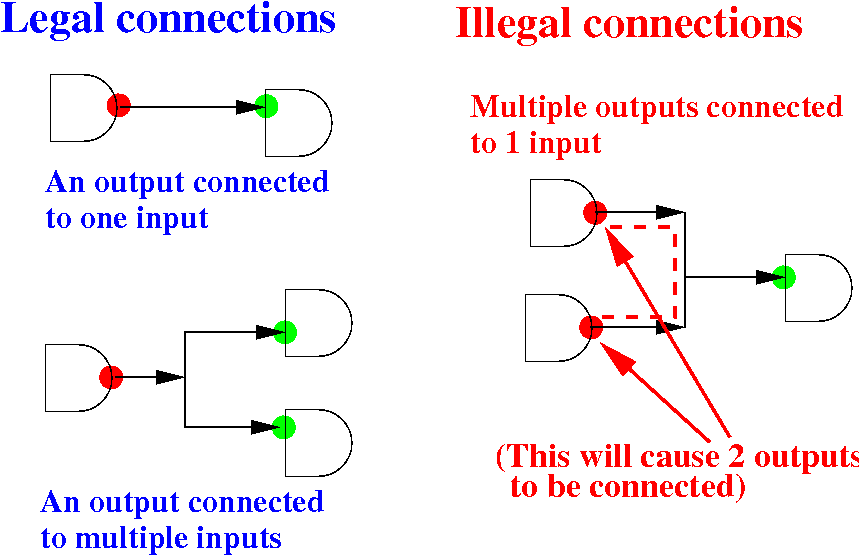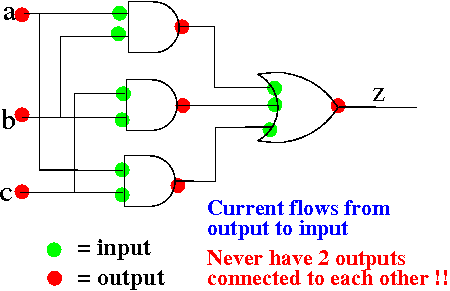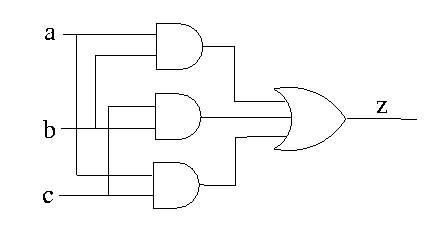The digital circuits are divided into 2 broad categories:
|
We will now study how to design (= make) combinatorial circuits that perform a certain function
|
Example of legal and illegal connection between circuit elements:

Note: later in the course, you will learn about a "high impedance" output circuit that can be connected together.
Example of a (digital) circuit:

|
Consider the following circuit with input signals: a, b, c and output signal: z:

Can you figure out the function performed by the following circuit ?
DEMO: /home/cs355001/demo/circuits/circuit1

a b c | p q r | z
----------+---------+----
0 0 0 | |
0 0 1 | |
0 1 0 | |
0 1 1 | |
1 0 0 | |
1 0 1 | |
1 1 0 | |
1 1 1 | |
|

a b c | p q r | z (p = a AND b)
----------+---------+----
0 0 0 | 0 |
0 0 1 | 0 |
0 1 0 | 0 |
0 1 1 | 0 |
1 0 0 | 0 |
1 0 1 | 0 |
1 1 0 | 1 |
1 1 1 | 1 |
|

a b c | p q r | z (q = b AND c)
----------+---------+----
0 0 0 | 0 0 |
0 0 1 | 0 0 |
0 1 0 | 0 0 |
0 1 1 | 0 1 |
1 0 0 | 0 0 |
1 0 1 | 0 0 |
1 1 0 | 1 0 |
1 1 1 | 1 1 |
|

a b c | p q r | z (r = a AND c)
----------+---------+----
0 0 0 | 0 0 0 |
0 0 1 | 0 0 0 |
0 1 0 | 0 0 0 |
0 1 1 | 0 1 0 |
1 0 0 | 0 0 0 |
1 0 1 | 0 0 1 |
1 1 0 | 1 0 0 |
1 1 1 | 1 1 1 |
|

a b c | p q r | z (z = p OR q OR r)
----------+---------+----
0 0 0 | 0 0 0 | 0
0 0 1 | 0 0 0 | 0
0 1 0 | 0 0 0 | 0
0 1 1 | 0 1 0 | 1
1 0 0 | 0 0 0 | 0
1 0 1 | 0 0 1 | 1
1 1 0 | 1 0 0 | 1
1 1 1 | 1 1 1 | 1
|
Question: what function does this circuit compute ???

a b c | p q r | z (z = p OR q OR r)
----------+---------+----
0 0 0 | 0 0 0 | 0
0 0 1 | 0 0 0 | 0
0 1 0 | 0 0 0 | 0
0 1 1 | 0 1 0 | 1
1 0 0 | 0 0 0 | 0
1 0 1 | 0 0 1 | 1
1 1 0 | 1 0 0 | 1
1 1 1 | 1 1 1 | 1
|
Output z = 1 if and only if a majority of the input values = 1 !!
|
We will study this circuit design problem next
